(1) The purpose of the web pages below is to provide some general info on what to wear at swing dances, where to get clothes/shoes for swing dancing, etc.
(2) In addition, info is provided for those that may have an interest in dressing, and dancing, in vintage clothes. Mike & Mary Richardson have won several swing-era, i.e. 1930’s/40’s vintage best dressed contests (couple and/or individual); and we often swing dance in our vintage clothes and shoes. Also, feel free to ask us questions, we are happy to share our knowledge and expertise!
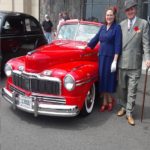
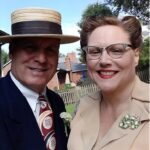
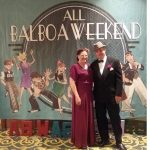

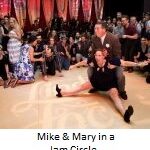
General information.
General information. Our primary recommendation is to dress for comfort, but dress nice – and don’t be afraid to get a bit dressed up!
- Men: Bring extra outer shirts and T-shirts! Let’s face it, most men sweat when swing dancing….take care of your personal hygiene at swing dances. Followers don’t like to dance with men that have big sweat spots on their clothes, dripping sweat from their face, arms, etc…
- Ladies: Avoid sleeveless shirts and tank tops. It is not pleasant to have to touch the damp skin of a partner. Long hair should be put up or tied in a ponytail. It’s difficult to get into closed dance position when the lady has long flowing hair (hair can get caught in the gentleman’s right hand). It’s also not fun to be hit in the face with flying hair (especially wet hair) during turns and spins.
- If you dance on a regular basis, you’ll need to invest in some good dance shoes designed for swing dancers, both for swing dances and lessons. You really can’t get beyond the beginner level if you try to dance in tennis shoes (not counting tennis shoes that have chrome leather applied to the bottoms), work type shoes, climbing boots, ballroom- type dance shoes, crocs, etc.
- Unlike most other dance events that are rather sedate and calm, a lot of swing dances have more up beat and up-tempo music and will get you “warmed up” in a hurry. After a night of swing dancing, we sometimes hear people remark that they feel “tired”. We suspect that feeling may come from wearing clothing that just makes you too darned hot and dance shoes (or street shoes) that don’t provide cushion or support.
- If one wears good dance shoes and comfortable clothing, a good night of swing dancing will leave you with a feeling of gentle fatigue.
A word about these recommendations for the beginner, and those taking the Hepcats group classes.
We don’t necessarily recommend that people new to swing dancing buy a lot of shoes or clothing until they’ve gotten some experience with swing dancing, and have an idea of what they want. If you’re in a beginner level class, you don’t need any special shoes or clothing, but we do recommend the following:
- Wear clothes that are comfortable and are not restrictive to your movement (for example, long tight skirts on ladies). A good guideline is that anything is fine, as long as it’s comfortable and tasteful.
- Wear shoes with flat soles (high heels are not recommended) that grip your ankle. Comfortable dress shoes, like loafers or wing tips with a leather sole, are also fine to start.
- Wear light shoes without a lot of traction so you can spin with less strain on your knees and ankles. (Note that hiking boots and similar type shoes that are “heavy” with lots of traction are not good.)
See below for more specific info on dance shoes, clothes, and vintage clothing.
There are lots of different manufacturers and styles of dance shoes on the market, some more suitable/comfortable for swing dancing than others.
Not particularly suitable for swing dancing.
Ballroom Dance Shoes. Ballroom dance shoes have very little lateral and arch support, and often little insole cushion. The soles normally have a very thin layer of suede leather on the sole. Ballroom Dance Shoes are easily ruined if used on something other than a nice, smooth, clean wooden or tiled dance floor.
Character Shoes (named for their use in musical theatre by those performing “in character”). These shoes have a very generic look and almost always come with very hard, leather soles. Character Shoes normally do not have a built in cushion insole.
Jazz Shoes. Made for jazz and modern dance, these type shoes can be purchased with split sloes for more flexibility. The soles will normally be rubber, chrome leather (suede), or a chrome leather sole with a rubber heel. Like ballroom dance shoes, these type shoes are light but lack much lateral and/or arch support.
Recommendations for shoes for swing dancing. If you do a lot of swing dancing, it’s certainly wise to invest in some dance shoes (and cushioned insoles) that provide comfort, support and the proper sole for slides, hops, jumps, swivels and spinning (especially the ladies, who often do a lot of spinning!).
Dancing can take a toll on your knees, ankles and legs if you don’t have good shoes. Overall, you want shoes that let you pivot freely (to avoid knee and ankle damage), but not let you slip and fall. Let’s look at some shoes made specifically for swing dancers. See the info below in the section on “Where to buy….” for specific recommendations.
Vintage Shoes. Vintage shoes are one of the best choices to make when looking for dance shoes. Yes, they are harder to find, and cost a bit more than “regular” shoes. But often times shoes from the 1930’s/40’s/50’s were made much better than shoes today, and of course, that vintage look is hard to beat. A word of caution: before you start purchasing vintage shoes, get educated on the subject. Talk to other swing dancers that wear vintage shoes to get advice on where to buy vintage shoes and other any advice they may have. Yes, that will take some time and effort, but it’ll be worth it!
Cushioned Insoles. A good pair of cushioned insoles are worth their weight in gold. There are lots of name brand and off-brand insoles on the market. Some people will buy their shoes slightly bigger (perhaps a half size bigger) to give them more room. Insoles come in relatively flat versions and those with combinations of molded heel cup and arch support. You can even add a “flat” type cushioned insole under the combination type to really increase the cushion and support.
A note on Athletic Shoes with Chrome Leather Soles. Some swing dancers wear athletic shoes. These shoes have layers of rubber and foam that cushion and support your feet. However, as we all know, athletic shoes are built to “grip” the floor, and if you try to dance (or do any turns or spinning) in rubber soled shoes you can easily hurt or injure your knees or ankles. So what’s a (partial) solution? Chrome or a hard leather sole.
Take a pair of your stylish athletic shoes (preferably with a flat sole, i.e. not running athletic shoes) to a shoe repair store and have chrome leather (note thin suede leather) or a hard leather sole bonded or glued on. Once again, ask for the thicker chrome leather or a hard leather sole, and not the thin suede that is often used on ballroom dance shoes.
Note you can also use the “Chrome Leather” or “Hard Leather” solution on lots of other different shoes that give you good support, such as two-tone spectators, bowling shoes, vintage shoes, etc.
Lastly, note the big disadvantages of wearing tennis shoes with chrome leather or even a hard leather sole are (1) it’s difficult to do heel and floor slides and (2) they’re tennis shoes, an informal style shoe, that doesn’t look good with more formal clothes, i.e. a suit, jacket, etc…
The bottom line for what to wear to a swing dance: dress nice and tasteful. Remember, dancing is a social activity and you’re interacting with other people, so try to look like you care!
Think about it……guys, do you think women will want to dance with you, or be attracted to you if you’re wearing ratty looking blue jeans, or cargo pants, or sweatpants and a dingy looking t-shirt? Ladies, do you think guys will want to dance with you, or be attracted to a lady that looks frumpy and dowdy? It’s worth repeating, for both guys and gals – dress nice!
At a minimum, it should be “dressy” casual or business casual at a swing dance. Some attendees like to get dressed up, and that’s fine! People also tend to get more dressed up for events with live music, such as the Hepcats Big Band Swing Dances, the Saturday night dance at the All Balboa Weekend, the nightly dances at Lindy Focus, etc…
Generally, keep comfort in mind, and note that swing dancing keeps you movin’! Be sure to wear comfortable shoes. (To protect the dance floor, no boots, “spiked” high heels or similar type shoes should be worn.)
For classes. Wear loose comfortable clothing and flat-soled shoes. We don’t recommend blue jeans because they’re too restrictive. We also don’t recommend high heels or open, strapped shoes or sandals or flip flops.
Vintage Style. Some people prefer to wear vintage clothing at swing dances, i.e. wide legged pants, two tone shoes, “swishy” skirts or dresses, etc. While this is never required, it is fun and adds to the overall atmosphere of a swing dance. Where do you get vintage style clothes? In good vintage stores, on-line….. see the info below.
Skirts vs. Pants. Generally speaking, I prefer dresses or skirts, as pants can get hot. Although some women wear long pants, I don’t recommend heavy jeans. Light weight Capri pants, or drawstring pants are not only comfortable, but also quite acceptable at swing dances. Also, swing dancing does wonderful things for one’s calf muscles. Why not show them off?
Shirts. I prefer short sleeves. Sometimes leaders grab hold of the forearm instead of the hand and having hanging, long sleeves can get in the way. I don’t recommend going sleeveless, or wearing spaghetti straps; armpits are not a women’s most attractive feature. I also do not recommend anything backless. Most leaders do not enjoy putting their hand on a sweaty back.
Fabrics. I find that the newer rayon and nylon blends work very well. Even when they get damp from perspiration, they tend to dry quickly. Lightweight cotton weaves are okay, but cotton knits tend to hold moisture and can feel heavy when wet. Some washable silks are ok, but do a small spot test to see if it changes colors when wet. Anything “Dry Clean Only” is not recommended.
Whatever you decide to wear or buy, before you leave home or leave the store dressing room, move around in the outfit, raise your arms over your head, sit down in it, etc. Does it ride up? Does it show too much of the wrong thing? You do not want to spend half the evening adjusting your clothing.
Hair. Anything over shoulder length should be pulled back, or up or brought under control in some way. Swing dancing is an athletic activity, and you’re going to perspire. Leaders don’t enjoy beging smacked in the face by a wet mop!
The Vintage Look and the Casual Look.
The Vintage Look. I wear vintage clothing for most swing dances I attend, so you’ll see me with a dress shirt, suit/jacket and tie (except for outdoor events). For more info on Vintage Look, see this link.
The Casual Look. For the occasions I don’t wear a suit/jacket and tie (which are few), the info below are the key considerations for me.
Shirts — First, let’s cover what I don’t find comfortable.
Silk. Silk may be okay if you’re not moving around much, but silk (1) doesn’t “breathe” and soaks up perspiration, thus retaining a lot of body heat; (2) changes color as it absorbs perspiration, giving a very unpleasant appearance, and (3) loses its shape as it gets wet from perspiration.
Cotton. Cotton, especially the 100% heavy-weight variety, is not very comfortable for swing dancing, for most of the same reasons that silk is not. Cotton really soaks up the sweat and after a couple of dances of even moderate exertion it makes you feel like you’re wearing a towel.
T-Shirts or Polo Shirts. I don’t recommend T-shirts or Polo Shirts for dancing, even in an extremely casual setting. I really haven’t found a T-Shirt or Polo Shirt fabric that is suitable for dancing. If you decide to wear T-shirts or Polo Shirts, take extras so you can change when those get wet.
Shirts — What’s comfortable.
Button up, short sleeve shirts – rayon and nylon blends. I’ve found that the newer rayon and nylon/polyester blends can be comfortable for dancing. They dry quickly, keep their shape and hold up well after repeated washings. Look for shirts that are comfortable to move around in (especially as you move your arms upwards for underarm turns) and are “smooth” to the touch. And when wearing these type shirts, I most often wear the shirt un-tucked, which allows some air flow.
Plain T-Shirts Underneath. I like to wear a plain v-neck t-shirt under my outer shirt. This helps soak up the some of sweat, doesn’t retain too much body heat and provides a “barrier” for helping keep the outer shirt dry. I take extra T-shirts and shirts to dances to change as needed. Taking extras T-shirts and shirts is especially important for outdoor dances (and followers really appreciate that!).
Note: I gladly give credit to my wife Mary for her advice and expertise on vintage clothing, although she is in no way responsible for any of my fashion mistakes!
Some advice on dressing vintage / vintage clothing that applies to men and women.
o Authentic Vintage Clothing. Authentic vintage clothing (i.e. from the early 1950’s and earlier) in good condition can be hard to find, especially in the larger sizes. For a variety of reasons, people were generally smaller 50-75 years ago, both in height and in “girth”. It’s certainly not impossible to find vintage clothing in larger sizes, but smaller sizes are much more common. And larger size vintage clothes often cost more. But don’t give up, keep looking – part of the fun of vintage clothing is the thrill of the hunt!
A couple of other caveats. A lot of authentic vintage clothing is made of wool and doesn’t “breathe” well, can be fragile, and not hold up well to the rigors of swing dancing. If possible, avoid using the Dry Cleaners for vintage clothing. And as noted above, sizes for vintage clothes may run smaller, so keep that in mind if ordering from Ebay, Etsy or another on-line site.
o Reproduction Vintage Clothing. There are some on-line retailers that sell good quality reproduction shoes and clothing. Thrift stores (Goodwill, Salvation Army) are a possible source for clothing that is older, although not exactly vintage, but has a vintage look. For the ladies, note that wide shoulder pads were popular in a lot of dresses and shirts from the 1980’s, giving that clothing a vintage or 1940’s look.
o How to get started with vintage clothing. (1) See the info below for places to buy vintage clothing. (2) Note that Mike & Mary Richardson have good collections of vintage and vintage style clothing, so get with us and we’ll be happy to share any info we have and get you started in the right direction for vintage clothing.
Vintage clothing – some advice for men.
(1) Be persistent. As previously noted, authentic swing-era vintage clothing in good condition, especially in the larger sizes, can be hard to find. But don’t let that stop you – the hunt is part of the fun!
(2) If you got it, wear it. Over time, I’ve managed to acquire some really nice 1920’s/30’s/40’s/early 1950’s vintage clothing items: ties, shoes, suits, jackets, pants, overcoats, gloves, etc… I first started wearing vintage clothing when I would go out swing dancing. At most swing dance events I wear vintage clothing, primarily the 1930’s or 40’s vintage look. My wife Mary also likes to wear vintage clothing, and we often get compliments on our clothing choices.
But I was initially hesitant to wear vintage clothes as a part of my “regular” clothing choices. But now I feel very comfortable and confident wearing vintage clothes on a regular basis.
My advice is if you got it, wear it, but within reason, and of course, use common sense. For example, I keep it “toned down” when I wear vintage clothes to church (but even “toned down” I’m one of the better dressed gents at church). For example, I would personally not wear two tone spectator shoes to church. And while I have worn vintage clothes to many employer sponsored and work related social functions, I was pretty much polo shirt and khaki pants for my regular work hours.
(3) Esquire Magazine. I use Esquire Magazine from the 1930’s and 40’s as a source of inspiration and information for my personal styling choices. A couple of notes about Esquire Magazine of the 1930’s and 40’s.
Equire Magazine debuted in autumn of 1933 and was very successful from the start. It was really the first regularly published magazine dedicated to men’s fashion, with a combination of men’s clothing illustrations and advertising and well written articles on not just men’s fashion but also sports, humor and sometimes world politics and events.
For today’s men’s vintage clothes enthusiasts, the color illustrations and accompanying “banter” to those illustrations is without equal. The main artists for those Esquire illustrations were Laurence Fellows, Leslie Saalburg and Robert Goodman.
(4) Know your sizes! If buying vintage clothes from a store or online, you need to know your sizes. Pick some of your clothing that fits you well. Then take the measurements for your jacket, which would include shoulder-to-shoulder, sleeve, chest and length. And for trousers you’ll need to know your waist, rise and the inside leg measurements. For dress shirts, you’ll need collar, chest, sleeve and length. Of course in a vintage store, you want to try on any clothes you are considering buying. And hold the clothes up to a strong light or a well lit window, a good way to see if there are any moth holes.
(5) Keep “fit” in mind – and find a good alterations shop! For a lot of items you buy at a vintage store or on-line, you’ll need the services of a good alterations shop. Nothing wrong with getting an item altered a bit, i.e. taken in, let out, etc… But resist the temptation to wear vintage clothes that are just too big or too tight. Keep “fit” in mind!
(6) A note of caution about vintage clothes and swing dancing. Always consider the rarity and condition of your vintage clothes and how much wear and tear those vintage clothes will endure if you wear them swing dancing. For example, if you are going to a summer street dance or some other type of outdoor summer dance (where you will sweat a lot!), you probably shouldn’t wear your good vintage clothes. Stick with the vintage reproduction type clothes for those events. And of course, you wouldn’t want to wear your hard-to-find vintage shoes on concrete or some other similar dance floor surface.
 Now, on to the actual clothing!
Now, on to the actual clothing!
Jackets. For jackets I prefer a vintage jacket or sport coat: a solid color, houndstooth, herringbone or checked type pattern, with a wide, swing-era style lapel. Generally, you want the width of your tie to be in somewhat the same proportion as your jacket lapel.
herringbone or checked type pattern, with a wide, swing-era style lapel. Generally, you want the width of your tie to be in somewhat the same proportion as your jacket lapel.
Suits. For suits, I prefer a 1930’s or 40’s vintage suit, either 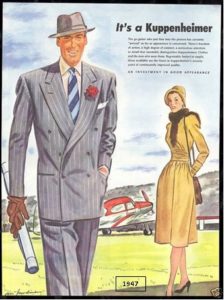 a doubled breasted or single breasted suit, with the peak and wide lapel, a very classy look! Suits can be hard to fine, especially in the larger sizes. And note you’ll probably need the services of a good tailor to fit almost any suit you buy second hand.
a doubled breasted or single breasted suit, with the peak and wide lapel, a very classy look! Suits can be hard to fine, especially in the larger sizes. And note you’ll probably need the services of a good tailor to fit almost any suit you buy second hand.
Pinstripe suits (generally grey/dark blue/brown) were worn a lot in the swing-era, but those type swing-era vintage suits can be hard to find (especially in the bigger sizes, as previously noted).
If you do wear a reproduction “swing-era style” suit or other reproduction vintage clothing, stick with the traditional colors, and not any “over the top” colors/color combinations. Keep in mind your goal should be to dress and look vintage, and not “cartoonish”.
And for summer events, I like the lighter color vintage look. And summer is the time to break out your two-tone spectator shoes.
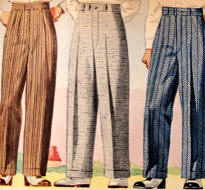 Pants. I most often wear vintage pants from the 1930’s, 40’s/early 50’s; once again, they can be hard to find in the larger sizes. Keep in mind that pants in the swing-era had a much fuller and generous cut than pants worn today.
Pants. I most often wear vintage pants from the 1930’s, 40’s/early 50’s; once again, they can be hard to find in the larger sizes. Keep in mind that pants in the swing-era had a much fuller and generous cut than pants worn today.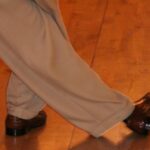
I usually go for a dress pant in a contrasting, but complimentary color to the jacket I wear. Note the pants should be cuffed, and not straight. If you get pants cuffed, ask for a 1.5-2.0″ cuff, the increased weight will help keep the pant leg straighter.
Remember to stick to the basic, classic colors – the goal is to look vintage/classy/stylish, and not “cartoonish”.
 Be careful of heavy wool pants. I find that a lot of the heavy wool blend pants retain a lot of heat and sweat when dancing, although they do hold their shape. If these heavy wool blend pants get really wet, they get even more heavy. Go for the wool pants with a light feel.
Be careful of heavy wool pants. I find that a lot of the heavy wool blend pants retain a lot of heat and sweat when dancing, although they do hold their shape. If these heavy wool blend pants get really wet, they get even more heavy. Go for the wool pants with a light feel.
Khaki or other casual type pants would seem to be a good choice for swing dancing but they really aren’t, and they generally don’t look 1930’s/40’s vintage. I find these type pants soak up sweat and rapidly lose their shape. And sweat pants, “gym” pants, cargo type pants or pajama type pants are really not appropriate for a social dance event (and really not appropriate for most social occasions).
Some pants made from cotton/linen blends are nice for outdoor swing dance events. Ensure the fabric has a “light” feel to it and that it will hold its shape.
Ties. Ties have an interesting history (but I digress!). Vintage ties are one of 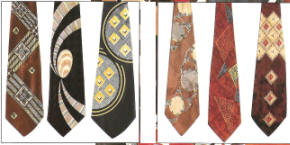 the easier vintage items to find (both on-line and at vintage stores), are generally affordable, and really give your clothing some “pop” and color.
the easier vintage items to find (both on-line and at vintage stores), are generally affordable, and really give your clothing some “pop” and color.
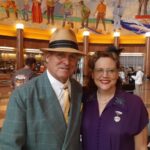 I like to wear vintage swing-era 1930’s, 1940’s/early 1950’s ties. Many of the mid 1940’s to early 50’s ties have a “bold”, “geometric” or “art deco” type pattern and a bright color. There were a multitude of different colors used for swing-era ties. Ties from the swing-era were generally about 44-52″ in length, shorter than ties worn
I like to wear vintage swing-era 1930’s, 1940’s/early 1950’s ties. Many of the mid 1940’s to early 50’s ties have a “bold”, “geometric” or “art deco” type pattern and a bright color. There were a multitude of different colors used for swing-era ties. Ties from the swing-era were generally about 44-52″ in length, shorter than ties worn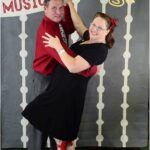 today and did not cover the belt buckle area (which is opposite of the general rule for today). Ties with a “geometric” or “art deco” type pattern were generally more prevalent in the mid 1940’s (generally post WW II) to about the early 50’s. Striped ties were more common in the 1930’s to about the end of WW II.
today and did not cover the belt buckle area (which is opposite of the general rule for today). Ties with a “geometric” or “art deco” type pattern were generally more prevalent in the mid 1940’s (generally post WW II) to about the early 50’s. Striped ties were more common in the 1930’s to about the end of WW II.
Dress shirts. For a dress shirt, I often wear a muted solid color, or small patterned or pinstriped dress shirt, almost always with long sleeves, sometimes with French cuffs, with a point or straight collar; sometimes I’ll wear a dress shirt with a button down or tab collar. I’m not a fan of spread collars for dress shirts, for a lot of men it (makes your neck look big. The 1930’s/40’s spear point collar shirt of the swing era is hard to find, but there are reproductions available on-line.
Beware of dress shirts with “too bright or a “neon” color, or a busy 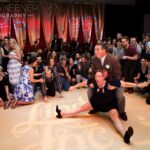 pattern (s); they can be difficult to “match up” and may “over power” your ensemble. A dress shirt with French cuffs gives a nice, classy look, although even those shirts new are a bit hard to find and normally cost more. And of course you’ll need cuff links for a French cuff shirt.
pattern (s); they can be difficult to “match up” and may “over power” your ensemble. A dress shirt with French cuffs gives a nice, classy look, although even those shirts new are a bit hard to find and normally cost more. And of course you’ll need cuff links for a French cuff shirt.
For French cuff shirts, go with vintage and classic looking cuff links (see info below). A tip from my wife: when swing dancing, wear cuff links with a rounded edge and not a square edge; the square edge type cuff link may scratch your dance partner.
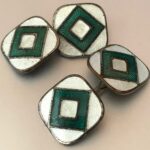
Cuff links. Vintage cuff links are relatively affordable and are somewhat easy to find, either at vintage stores or on-line. I prefer the art deco, enameled, double faced cuff links from the 1920’s and 30’s (which are harder to find and generally more expensive); avoid cuff links newer than the early 1950’s.
Shoes. My first preference is to wear vintage swing-era shoes from the 30’s/40’s/50’s. Men’s shoe styles didn’t change that much from ab out the late 1920’s to about the mid-to-late 1950’s. Along with the tie, vintage shoes can really give your outfit that vintage look. Two tone spectators (black and white, brown and white) are classic swing-era, along with spectators with a ventilated and/or mesh look.
out the late 1920’s to about the mid-to-late 1950’s. Along with the tie, vintage shoes can really give your outfit that vintage look. Two tone spectators (black and white, brown and white) are classic swing-era, along with spectators with a ventilated and/or mesh look.
If you buy vintage shoes on-line, make sure you check the measurements, and examine the pictures closely for condition. As with clothing, if you wear reproduction “swing-era style” shoes, stick to the basic, classic colors (brown/white, black/white) – as previously noted the goal is to look vintage/classy/stylish, and not “cartoonish”.
Dress Socks. Over the calf socks dress socks is the way to go for a dapper gent. As the name implies, over the calf socks fit over your calf, which keeps the socks from sliding down. Stick to the classic men’s wear colors and patterns; don’t go for the wild colors, like neon, and over the top patterns. And it goes without saying: don’t wear athletic socks with dress shoes.
Knitwear. Knitting is the process of turning thread and/or yarn into clothes; knitting has of course been around since ancient times. Machines for knitting been appearing around the 1850’s, and constant improvements were made in the machinery. By the 1920’s knitwear such as sweaters, cardigans, pullovers, sweater vests, etc.. were available in a great variety of colors, patterns, long and short sleeved.
Truly vintage knitwear can be hard to find. Keep an eye out for quality reproductions from establishments such as Simon James Cathcart, Revival Vintage UK, to name just a couple. The Ralph Lauren brand from the1980’s and 90’s also has some very good, vintage inspired knitwear.
Hats. A classic style 1930s/40s hat gives one a nice vintage look. Depending on the season and what clothing I’m wearing I like a nice Fedora, Homburg or Panama hat; and for a 1920’s Charleston look, try a Boater hat. As with clothes, vintage hats from the swing-era can be expensive and hard to find. Get up to speed on hat etiquette: in general, don’t wear your hat indoors!
Accessories. While you don’t want to go overboard, accessories can really add that something extra to your style. A pocket square and/or a boutonniere adds a nice touch. I sometimes wear a tie bar, but I hardly ever wear a tie clip (that can get in the way when dancing). And I don’t like tie pins, why stick a hole in your good vintage tie?!
Suspenders. Swing-era suspenders are another item that may be found on-line and in some vintage stores. In general, 1930’s/40’s suspenders were a bit on the narrow side compared to the “modern” suspenders you find today. Even though no one will see your suspenders (unless you take off your jacket), stick to the basic classic colors and patterns. Two definite no-nos if you wear suspenders: (1) never wear clip on suspenders, and (2) never wear a belt and suspenders at the same time.
A few reference works:
o Everyday Fashions of the Thirties, As Pictured in Sears Catalogs, ed. Olian, JoAnne.
o Everyday Fashions of the Forties, As Pictured in Sears Catalogs, ed. Olian, JoAnne.
o Everyday Fashions of the Fifties, As Pictured in Sears Catalogs, ed. Olian, JoAnne.
o Montgomery Ward Fashions of the Twenties, ed. Olian, JoAnne.
o Fit to Be Tied: Vintage Ties of the Forties and Early Fifties, Dyer, Rod, & Spark, Ron.
o 20th Century Neckties, Pre-1955, Ettinger, Roseann.
o A Dandy Guide to Dating Vintage Menswear, WWI through the 1960s, Nightingale, Sue.
o American Menswear, from the Civil War to the Twenty-First Century, Daniel Delis Hill.
o Cuff Links, Jonas, Susan and Nissenson, Marilyn.
o Men In Style: The Golden Age of Fashion From Esquire [Magazine], Hochswender, Woody.
o Esquire’s Encyclopedia of 20th Century Men’s Fashions, Schoeffler, O.E.
Web sites of interest:
o Gentleman’s Gazette. A very good web site with lots of useful for information and advice for classic men’s clothing and styling. Our society in general is casual about so many things, and men in particular often lack even the most basic understanding of clothing and styling. This web site (and a few others out there….), my experiences in the military, and most importantly sage and learned advice from my wife Mary have helped me gain a better understanding, and appreciation, of this subject, although my wife Mary is in no way responsible for any of my fashion mistakes!
o Vintage Menswear. A great Facebook group: info, pictures and posts about the clothing of the 1930’s, 40’s and 50’s.
o Vintage Coffee Club, Cincinnati, OH. A group of dapper gents that get together periodically.
Questions/more info? Feel to contact me, I’m always happy to provide info and share my expertise on men’s vintage clothing.
To be provided at some point in the future. In the meantime, feel free to ask Mary for info!
Most people acquire vintage clothing at vintage stores, on-line retailers and thrift stores. (Info below updated March 8, 2025.)
Vintage stores. These days, most vintage stores will carry more 1960’s, 1970’s and later styles of clothing (which is of course easier for the store to find) than 1930’s/40’s/50’s clothing. Clothing in a good vintage store is normally in good or better condition, but generally the better the condition, and the larger the size, the more the item will cost.
Local/Lexington area vintage stores. I’m sorry to say Lexington doesn’t have a really good vintage clothing store – you’ll need to travel to Cincinnati for that. But there are a few places in the Lexington area that do carry some vintage clothing items:
o Street Scene, 2757 Regency Rd., Lexington, KY; 859-260-1578. A variety of vintage items, what clothes they carry are normally 1960’s, 70’s, 80’s. Occasionally you can find something from the 1940’s/50’s.
o Feather Your Nest, 1317 West Main Street, Lexington, KY; 859-381-1505. Not a lot of clothing, but Mary and I have found some nice vintage items at this store. For watch and jewelry sales and service, check out A to ZEE, located inside this establishment; Phil is very knowledgeable and helpful.
o Pops Resale, 1423 Leestown Rd., Lexington, KY; 859-254-7677. Mostly vinyl records and such; some vintage clothes, although most of it is 60’s/70’s.
o The Domestic, 945 National Ave., Lexington, KY 40502; 859-309-3603. A variety of vintage items, not a whole lot of clothes, and what they carry is normally 1970’s/80’s/90’s.
o Wearhouse, 941 National Ave., Ste. 120Lexington, KY 40502; 859-354-9484. Mostly women’s clothes, mostly 1970’s/80’s/90’s.
Out of town vintage stores (just a few that we know of; let us know if you find a good vintage store or shop!)
Cincinnati – Mike and Mary try to visit one or more of these vintage stores on our trips to Cincy; all three establishments listed below are well worth a trip to Cincy:
o Talk of the Town, 9111 Reading Rd., Cincinnati, OH, 45215-3231; 513-563-8844.
o Casablanca Vintage, 3944 Spring Grove Ave., Cincinnati, OH, 45223-2639; 513-541-6999.
o Hi-Bred Vintage, 4041 Hamilton Ave., Cincinnati, OH, 45223; 513-240-4664.
Louisville
o Craft Union Vintage, 1519 Baxter Ave, Louisville, KY 40205; 502-416-8697.
o Nitty Gritty, 996 Barret Ave., Louisville, KY 40205; 502-583-3377.
o Fleur de Flea, 947 E. Breckinridge St., Louisville, KY 40204
Cleveland – Mike & Mary try to visit these vintage stores when we attend the All Balboa Weekend (ABW):
o Sweet Lorain, 7105 Lorain Road, Cleveland, OH; 216-281-1959.
o Flower Child, 11508 Clifton Blvd., Cleveland, OH 44102; 216-939-9933. Note: Flower Child also has a location in Columbus: 233 E. 5th Ave., Columbus, OH 43201; 614-297-8006.
On-Line Retailers.
o DanceStore.com. This web site sells Aris Allen shoes. These shoes come in some of different styles and colors. For the men, Aris Allen has styles with an all-leather sole & heel, which allows them to slide easily on the dance floor, and they normally have at least one model in a wide (E) size. For the ladies, they make several styles of the early 1940’s wedge shoe.
o Re-Mix Shoe Company. Reproduction vintage style shoes. Note: Re-Mix Shoe Company is often a vendor at national level weekend workshop events, i.e. the All Balboa Weekend (ABW).
o Muffy’s. On-line source for Saddle Shoes.
o Bleyers. Bleyers are made in Germany and used to be very popular with swing dancers, but I hardly ever see swing dancers wearing Bleyers these days, probably because of the easier availability of Aris Allen shoes. These shoes are lightweight, normally come with a synthetic type sole, provide good shock absorption, but are a little deficient in lateral support.
Mostly for the ladies:
o www.ModCloth.com. Lots of cool stuff for the ladies. This link also provides coupon and discount info for ModCloth.
o www.shabbyapple.com. Slightly expensive, but you can usually catch a few good sales.
Mostly for ladies, some stuff for guys:
o www.heydayonline.co.uk. A British vintage company that allows you to purchase vintage patterns made for your sizing.
Mostly for guys, some stuff for ladies:
o Simon James Cathcart (SJC), London, England. A little pricey, but high quality. I find their sizing can be a bit inconsistent. From their website: ” SJC is an apparel brand founded by Simon James Cathcart, it is supported by experienced collectors, buyers, designers and artists who share, develop and engage in the process of bringing the best garments we can to you. Our goal is not to copy vintage directly but to merge the finest aspects of several pieces into one to create the best example of that piece you could wish for.”
o Thomas Farthing, London, England. A little pricey, but high quality. From their web site: “At Thomas Farthing, each individual garment is designed with careful consideration of materials, colours and shapes, taking inspiration from our collection of 1930-40s archival pieces and photography. We work with skilled, long-standing manufacturers within The U.K. and Europe, each specialising in a specific field of expertise.”
o Chester Cordite, London, England. A bit pricey, but high quality. From their web site: “A modern take on classic styles from the golden age of 1930s and 1940s, producing limited edition suits and shirts with period influenced fabrics at splendidly affordable prices.”
For guys and ladies.
o RevivalVintageUK. This site offers decent quality vintage and reproduction items.
o Etsy and Ebay. Lots of sellers of vintage clothing/items on-line. More high quality items on Etsy than Ebay; and more sites for women’s clothing than men’s. A big advantage to these sites is of course the search options.
On Etsy, a couple of shops worth checking out are OverAttiredVintage and CityVintageClothes.
Thrift stores. Check out Goodwill or Salvation Army. The cost for shoes and clothes at these type stores is generally a good deal, but finding 1940’s/50’s clothing is difficult, as to be expected. Before buying any item at a thrift store, always try it on and check it thoroughly for holes, tears, stains, etc.
Shoe Repair and Tailor Services.
o Awesome Time Shoe and Leather Repair, located in Casablanca Vintage, 3944 Spring Grove Ave., Cincinnati, OH, 45223-2639; 513-541-6999. Tim does great work at a fair price – worth the drive to Cincy!
o Tony’s Shoe Repair, 144 W. Short St., Lexington, KY 40507. Haven’t used this establishment, but have heard good things about it.
o Bluegrass Shoe Repair, 820 Lane Allen Rd., Ste. 136, Lexington, KY, 859-278-3031. Mixed reviews on this establishment. Probably okay if all you need is to have hard leather (or chrome leather) affixed to the bottom of your dance shoes. Other than that, use one of the other two establishments noted above. Note this establishment does have a nice selection of shoe polish, shoe laces and other shoe related items.
o Juliya’s Alterations, 109 Springdale Dr #2 (off Harrodsburg Road, just across the Fayette/Jessamine county line, behind the Marathon Gas Station), Nicholasville, KY 40356; 859-312-9663. For altering the length of pants and sleeves of jackets, they do a good job at a fair price.
o Alterations & Sew Much More, 820 Lane Allen Rd., Ste. 143, Lexington, KY, 859-276-0226. An alterations shop that does good work at a fair price.